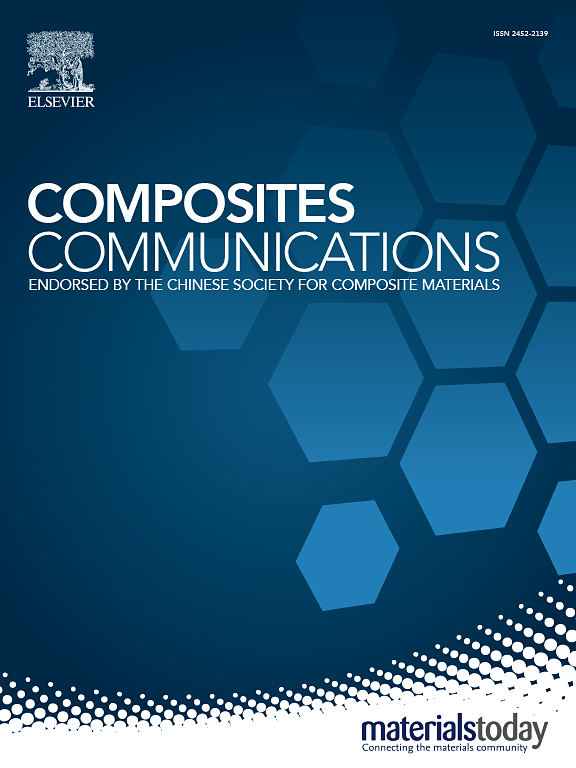采用环保方法在水乙醇溶剂中制造隔热、阻燃和超疏水聚苯并恶嗪/二氧化硅气凝胶
IF 6.5
2区 材料科学
Q1 MATERIALS SCIENCE, COMPOSITES
引用次数: 0
摘要
聚苯并恶嗪(PBz)气凝胶作为一种创新的优良隔热材料,以其轻质、低导热性和出色的机械性能而备受关注。然而,在制备过程中使用高沸点有毒溶剂需要进行繁琐的溶剂交换,而且阻燃性能不足,这些都阻碍了 PBz 气凝胶的潜在应用。在此,我们采用一种简便、环保、无成本的工艺,将正硅酸四乙酯(TEOS)加入到 PBz 中,通过热催化(72 °C)开环聚合,并在水乙醇溶剂中缩聚,在不使用任何催化剂的情况下获得了混合结构的聚苯并恶嗪/二氧化硅(PBz/SiO2)气凝胶。所制备的 PBz/SiO2 气凝胶具有密度低(0.181 g/cm3)、导热系数低(0.0315 W/(m-K))、阻燃性好(PHRR 值为 32.3 W/g,THR 值为 6.3 kJ/g)和超疏水性(水接触角高达 155°)等特点。PBz/SiO2气凝胶的环保制备策略具有优异的综合性能,有望在节能建筑和防火应用中发挥关键作用。本文章由计算机程序翻译,如有差异,请以英文原文为准。
Thermal insulating, flame retardant, and superhydrophobic polybenzoxazine/silica aerogels fabricated in water-ethanol solvent using eco-friendly method
Polybenzoxazine (PBz) aerogels have garnered considerable attention as an innovative and excellent thermal insulation material, celebrated for its lightweight, low thermal conductivity, and outstanding mechanical properties. However, the use of high boiling point toxic solvents in the preparation process requires a cumbersome solvent exchange procedure coupled with insufficient flame-retardant properties, which hinder the potential application of PBz aerogels. Herein, we employed tetraethyl orthosilicate (TEOS) into PBz using an easy, eco-friendly, and cost-less process to achieve hybrid structure polybenzoxazine/silica (PBz/SiO2) aerogels, by thermal catalysis (72 °C) ring-opening polymerization and polycondensation in water-ethanol solvent without any catalysts. The resulting PBz/SiO2 aerogels were characterized with low density (0.181 g/cm3), low thermal conductivity (0.0315 W/(m·K)), excellent flame-retardancy (PHRR value of 32.3 W/g and THR value of 6.3 kJ/g), and superhydrophobicity (the water contact angle up to 155°). Environment-friendly preparation strategy for the PBz/SiO2 aerogels with excellent comprehensive performance, poised to play a pivotal role in energy-saving buildings and fire-resistant applications.
求助全文
通过发布文献求助,成功后即可免费获取论文全文。
去求助
来源期刊

Composites Communications
Materials Science-Ceramics and Composites
CiteScore
12.10
自引率
10.00%
发文量
340
审稿时长
36 days
期刊介绍:
Composites Communications (Compos. Commun.) is a peer-reviewed journal publishing short communications and letters on the latest advances in composites science and technology. With a rapid review and publication process, its goal is to disseminate new knowledge promptly within the composites community. The journal welcomes manuscripts presenting creative concepts and new findings in design, state-of-the-art approaches in processing, synthesis, characterization, and mechanics modeling. In addition to traditional fiber-/particulate-reinforced engineering composites, it encourages submissions on composites with exceptional physical, mechanical, and fracture properties, as well as those with unique functions and significant application potential. This includes biomimetic and bio-inspired composites for biomedical applications, functional nano-composites for thermal management and energy applications, and composites designed for extreme service environments.
 求助内容:
求助内容: 应助结果提醒方式:
应助结果提醒方式:


